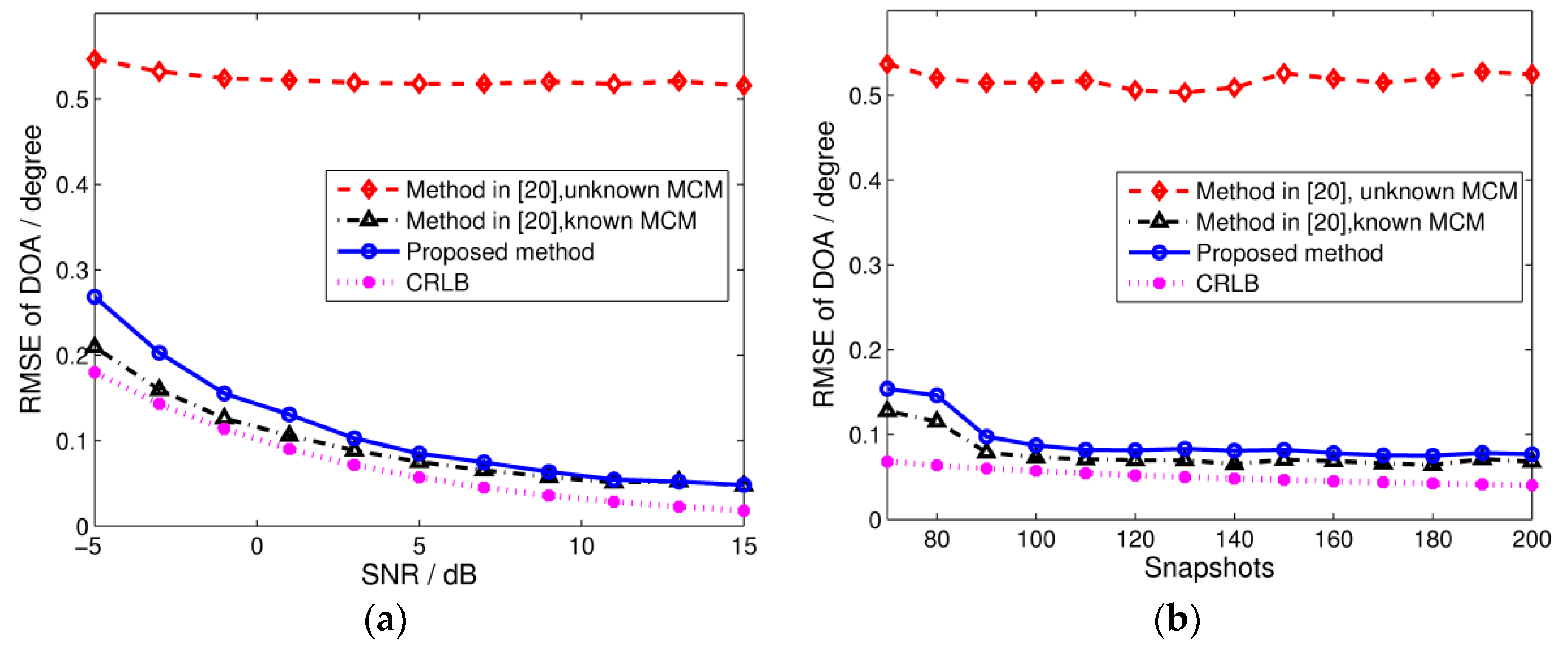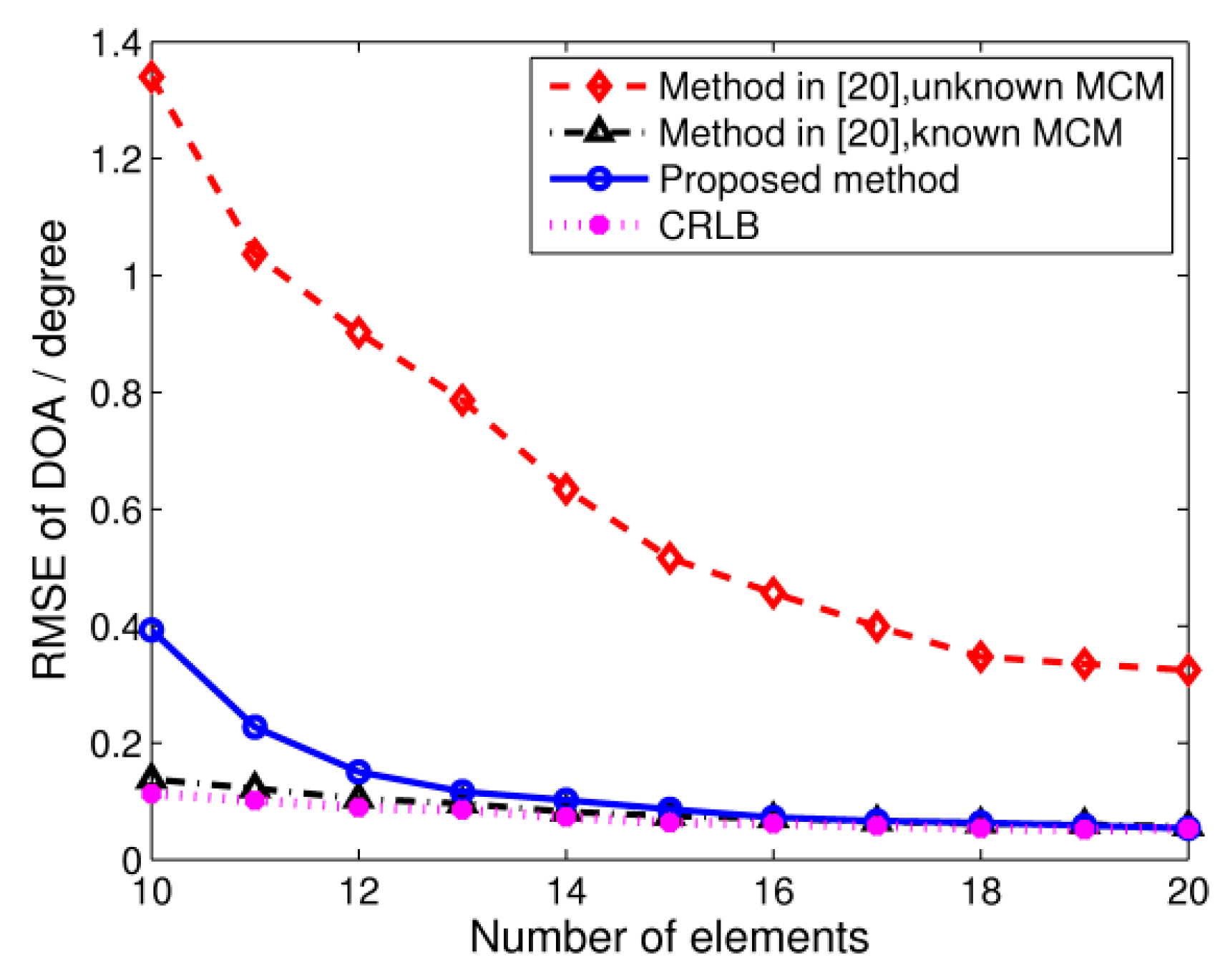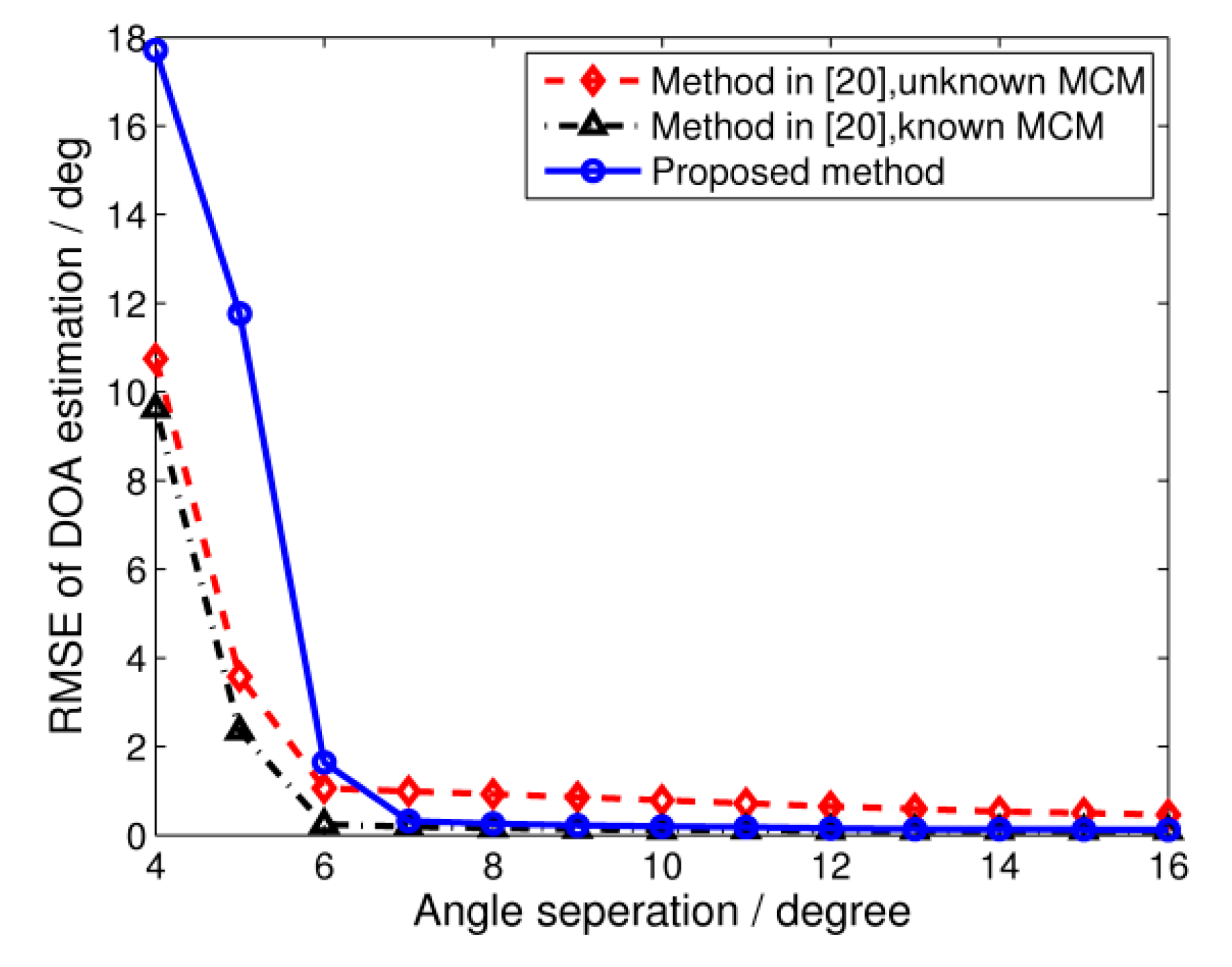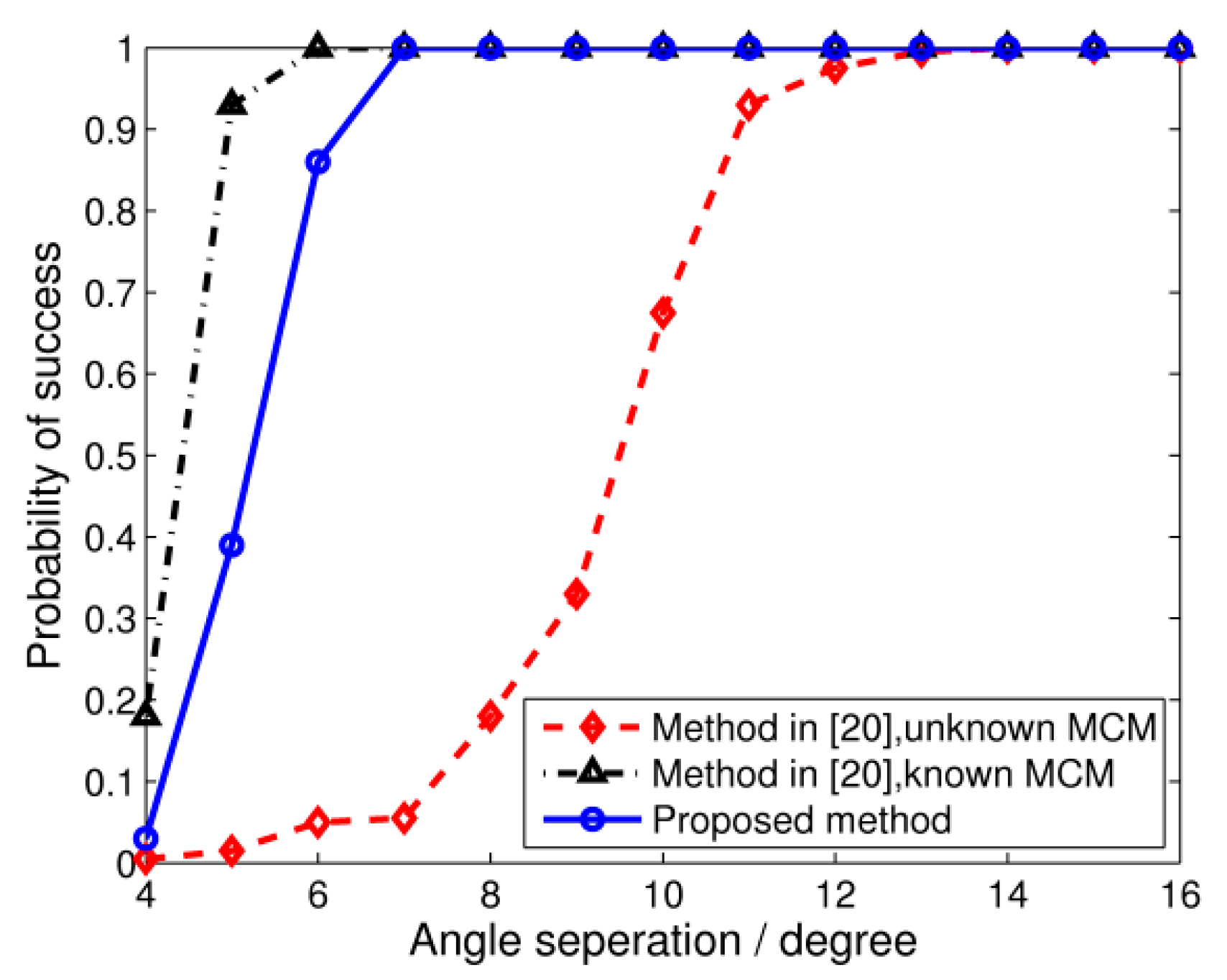Wideband Direction of Arrival Estimation in the Presence of Unknown Mutual Coupling
Abstract
:1. Introduction
2. Problem Formulation
3. Subarray-Based Wideband DOA Estimation Algorithm
3.1. Derivation of Focusing Matrices
3.2. DOA Estimation with Unknown Mutual Coupling
3.3. Discussion
- (1)
- Divide the array outputs into non-overlapping time slices, each containing samples, and apply DFT in each slice to sample the spectrum of the outputs at a group of frequency bins .
- (2)
- Select the outputs of the middle subarray from Equation (9). The number of nonzero mutual coupling coefficients can be obtained by preliminary measurements at the lowest operating frequency.
- (3)
- Find at the preselected focusing frequency. For each frequency bin, determine and construct the focusing matrix using Equation (20).
- (4)
- Calculate the general focused correlation matrix using Equation (21).
- (5)
- Apply the MUSIC method to for the estimation of the DOA.
- (6)
- In order to avoid blind angles, we choose several focusing frequencies and repeat steps (3) to (5) and then search the peaks of the averaging spectrums in Equation (28). However, considering the cost of computation, this step is usually skipped unless we find some signals are lost.
4. Simulation Results
5. Conclusions
Acknowledgments
Author Contributions
Conflicts of Interest
Appendix A
References
- Cantrell, B.; Rao, J.; Tavik, G.; Krichevsky, V. Wideband array antenna concept. IEEE Trans. Aerosp. Electron. Syst. 2006, 21, 9–12. [Google Scholar] [CrossRef]
- Toktas, A.; Akdagli, A. Compact multiple-input multiple-output antenna with low correlation for ultra-wideband applications. IET Microw. Antennas Propag. 2015, 9, 822–829. [Google Scholar]
- Schmid, C.M.; Schuster, S.R.; Stelzer, A. On the effects of calibration errors and mutual coupling on the beam pattern of an antenna array. IEEE Trans. Antennas Propag. 2013, 61, 4063–4072. [Google Scholar] [CrossRef]
- Sha, Z.C.; Liu, Z.M.; Huang, Z.T.; Zhou, Y.Y. Covariance-based direction-of-arrival estimation of wideband coherent chirp signals via sparse representation. Sensors 2013, 13, 11490–11497. [Google Scholar] [CrossRef] [PubMed]
- Hui, H.T. A practical approach to compensate for the mutual coupling effect in an adaptive dipole array. IEEE Trans. Antennas Propag. 2004, 52, 1262–1269. [Google Scholar] [CrossRef]
- Gupta, I.J.; Ksienski, A.A. Effect of mutual coupling on the performance of adaptive arrays. IEEE Trans. Antennas Propag. 1983, 31, 785–791. [Google Scholar] [CrossRef]
- Friedlander, B.; Weiss, A.J. Direction finding in the presence of mutual coupling. IEEE Trans. Antennas Propag. 1991, 39, 560–573. [Google Scholar] [CrossRef]
- Dai, J.S.; Bao, X.; Hu, N.; Chang, C.Q.; Xu, W.C. A recursive RARE algorithm for DOA estimation with unknown mutual coupling. IEEE Antennas Wirel. Propag. Lett. 2014, 13, 1593–1596. [Google Scholar]
- Wang, Y.X.; Trinkle, M.; Ng, B.W.-H. DOA estimation under unknown mutual coupling and multipath with improved effective array aperture. Sensors 2015, 15, 30856–30869. [Google Scholar] [CrossRef] [PubMed]
- Ye, Z.F.; Liu, C. On the resiliency of MUSIC direction finding against antenna sensor coupling. IEEE Trans. Antennas Propag. 2008, 56, 371–380. [Google Scholar] [CrossRef]
- Mao, W.P.; Li, G.L.; Xie, X.; Yu, Q.Z. DOA estimation of coherent signals based on direct data domain under unknown mutual coupling. IEEE Antennas Wirel. Propag. Lett. 2014, 13, 1525–1528. [Google Scholar]
- Si, W.J.; Zhao, P.J.; Qu, Z.Y. Two-dimensional DOA and polarization estimation for a mixture of uncorrelated and coherent sources with sparsely-distributed vector sensor array. Sensors 2016, 16, 789. [Google Scholar] [CrossRef] [PubMed]
- Valaee, S.; Kabal, P. Wideband array processing using a two-sided correlation transformation. IEEE Trans. Signal Process. 1995, 43, 160–172. [Google Scholar] [CrossRef]
- Zhao, G.H.; Liu, Z.C.; Lin, J.; Shi, G.M.; Shen, F.F. Wideband DOA estimation based on sparse representation in 2-D frequency domain. IEEE Sens. J. 2015, 15, 227–233. [Google Scholar] [CrossRef]
- Liberal, I.; Caratelli, D.; Yarovoy, A. Conformal antenna array for ultra-wideband direction-of-arrival estimation. Int. J. Microw. Wirel. Technol. 2011, 3, 439–450. [Google Scholar] [CrossRef]
- Wu, X.H.; Kishk, A.A.; Glisson, A.W. Antenna effects on a monostatic MIMO radar for direction estimation, a Cramèr-Rao lower bound analysis. IEEE Trans. Antennas Propag. 2011, 59, 2388–2395. [Google Scholar] [CrossRef]
- Yang, L.; Tan, W.H.; Shen, Z.X.; Wu, W. Wide-band wide-coverage linear array of four semi-circular sector horns. IEEE Trans. Antennas Propag. 2012, 60, 3980–3984. [Google Scholar] [CrossRef]
- Pasala, K.M.; Friel, E.M. Mutual coupling effects and their reduction in wideband direction of arrival estimation. IEEE Trans. Aerosp. Electron. Syst. 1994, 30, 1116–1122. [Google Scholar] [CrossRef]
- Hirata, A.; Morimoto, T.; Kawasaki, Z. DOA estimation of ultra-wideband EM waves with MUSIC and interferometry. IEEE Antennas Wirel. Propag. Lett. 2003, 2, 190–193. [Google Scholar] [CrossRef]
- Wang, B.H.; Hui, H.T. Wideband mutual coupling compensation for receiving antenna arrays using the system identification method. IET Microw. Antennas Propag. 2010, 5, 184–191. [Google Scholar] [CrossRef]
- Huang, Q.L.; Zhou, H.X.; Shi, X.W. A new wideband mutual coupling compensation method for adaptive arrays based on element pattern reconstruction. Int. J. Antennas Propag. 2014, 2014. [Google Scholar] [CrossRef]
- Hong, T.D.; Russer, P. An analysis of wideband direction-of-arrival estimation for closely-spaced sources in the presence of array model errors. IEEE Microw. Wirel. Compon. Lett. 2003, 13, 314–316. [Google Scholar] [CrossRef]
- Liu, Z.M.; Huang, Z.T.; Yu, H.Q.; Zhou, Y.Y. Modeling of wideband array signal in presence of mutual coupling and its influence on DOA estimation. J. Syst. Eng. Electron. 2009, 31, 1856–1860. [Google Scholar]
- Huang, Q.L.; Zhou, H.X.; Shi, X.W. A new compensation method for the mutual coupling effect in wideband 2D direction-of-arrival estimations. Electromagnetics 2013, 33, 517–525. [Google Scholar] [CrossRef]
- Zhang, Y.; Bao, Q.L.; Yang, J.; Chen, Z.P. Design and implement of equalization method for wideband digital array radar. Signal Process. 2010, 26, 453–457. [Google Scholar]







© 2017 by the authors. Licensee MDPI, Basel, Switzerland. This article is an open access article distributed under the terms and conditions of the Creative Commons Attribution (CC BY) license ( http://creativecommons.org/licenses/by/4.0/).
Share and Cite
Li, W.; Zhang, Y.; Lin, J.; Guo, R.; Chen, Z. Wideband Direction of Arrival Estimation in the Presence of Unknown Mutual Coupling. Sensors 2017, 17, 230. https://doi.org/10.3390/s17020230
Li W, Zhang Y, Lin J, Guo R, Chen Z. Wideband Direction of Arrival Estimation in the Presence of Unknown Mutual Coupling. Sensors. 2017; 17(2):230. https://doi.org/10.3390/s17020230
Chicago/Turabian StyleLi, Weixing, Yue Zhang, Jianzhi Lin, Rui Guo, and Zengping Chen. 2017. "Wideband Direction of Arrival Estimation in the Presence of Unknown Mutual Coupling" Sensors 17, no. 2: 230. https://doi.org/10.3390/s17020230




